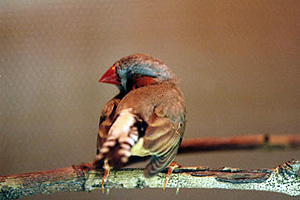Study on birdsong reveals learning during sleep
By William Harmsw-harms@uchicago.edu
News Office
 |
|
The reorganization of neural activity during sleep helps young songbirds develop the vocal skills they display while awake.
Sleep is known to influence a broad range of learning processes studied in humans, including acquiring such complex skills as video game playing and learning speech dialects. However, the neural mechanisms involved are not well understood.
To study this, University researchers turned to an animal model system, the developmental learning of song in songbirds, which long has been known to share features with learning speech and language.
Sylvan Shank, a recent Ph.D. graduate in Psychology, and Daniel Margoliash, Professor in Organismal Biology & Anatomy and Psychology, report in the Wednesday, Dec. 17 issue of Nature, that when young zebra finches listen to an adult tutor’s song and then practice singing, the premotor neuronal activity in the brain is altered during the following night’s sleep. The newly formed pattern of spikes in nighttime activity carries information both about the tutor song and auditory feedback the birds hear while singing. These changes lead to improved singing that can be observed the following day.
The study, described in the paper, “Sleep and Sensorimotor Integration During Early Vocal Learning in a Songbird,” is the first direct observation of the nighttime activity related to vocal learning that was supported by the National Institute of Mental Health.
“This study takes big steps forward in finding out how sleep impacts learning,” Margoliash said. “We looked at juvenile birds at the first moments of learning. We gained insight into the role of auditory information in structuring sleep activity, which in turn, we speculate interacts with daytime activity to drive vocal learning.
Since the changes occur in the region of the brain that drives singing during the day, but occur prior to the changes in singing, this discovery provides a compelling hypothesis for how this learning might happen. Juvenile songbirds show complex, sleep-dependent circadian patterns of singing that have been observed during developmental vocal learning. Their songs have less structure each morning and regain their complexity each afternoon. This daily pattern of variation is important for song learning—birds that have the greatest variation early in development ultimately learn the best.
“We now have a new model for how this works,” said Margoliash. “At night, the auditory information that the bird was exposed to during the day is reactivated, [carried by the spontaneous activity of neurons], changing the structure of the neural networks. These changes interact with changes during the day as birds listen to tutor songs and practice singing.” The authors suggest that reactivation of sensory information at night might be a general mechanism for learning a new skill.
In the current study, the University team was, for the first time, able to observe changes in neuronal activity of juvenile zebra finches at the first moments of song learning. Using microelectrodes, the team observed changes in a region of the young zebra finch brain involved in singing—the so-called robust nucleus of the acropalium.
Shank and Margoliash first looked at the effects of exposing birds to different tutor songs. They then extended that work to the role of auditory feedback in driving learning. They wanted to see whether changes in the brain brought on during sleep after exposure to a new song were reinforced by practice as well as daytime listening. They theorized that the interaction of the listening followed by practice and sleep consolidation could explain how birds learn to sing new calls.
To test the role of auditory feedback on learning, the team used white noise at 100 decibels to prevent the birds from hearing themselves. In subsequent tests of their brain activity, the team found no increase in the activity after the exposure to white noise, even if the birds had listened to tutor songs. This finding demonstrated the importance of auditory feedback; after the white noise was eliminated, the birds began to learn normally.
“There is a very famous theory called the ‘template theory’ of birdsong learning,” Margoliash said. “This theory postulates that a sensory template is formed when listening to an adult tutor, and that this template is then used to evaluate auditory feedback. We knew neither the form nor the mode of action of the template. Now we understand that the template can influence learning via sleep, and that new template information is rapidly distributed throughout the brain.”
In adults, neurons in RA do not exhibit auditory activity during the day, yet their nighttime activity patterns reflect auditory signals. Margoliash speculates: “Perhaps dreams are so compelling because additional areas are recruited to process the sensory experience.”
![[Chronicle]](/images/sidebar_header_oct06.gif)